Argosarchus
Argosarchus is a monotypic genus in the family Phasmatidae containing the single species Argosarchus horridus, or the New Zealand bristly stick insect, a stick insect endemic to New Zealand (Argosarchus spiniger is now considered a junior synonym of A. horridus).[1] The name "horridus" means bristly in Latin, likely referring to its spiny thorax.
| Argosarchus | |
|---|---|
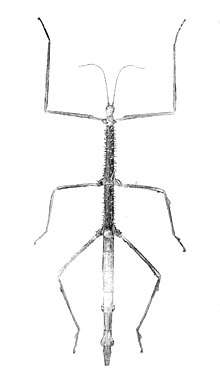 | |
| Argosarchus horridus by William Wing | |
| Scientific classification | |
| Kingdom: | |
| Phylum: | |
| Class: | |
| Order: | |
| Suborder: | |
| Family: | |
| Subfamily: | |
| Genus: | Argosarchus Hutton, 1898 |
| Species: | A. horridus |
| Binomial name | |
| Argosarchus horridus (White, 1846) | |
| Synonyms | |
|
Argosarchus spiniger (White, 1846) | |
Description
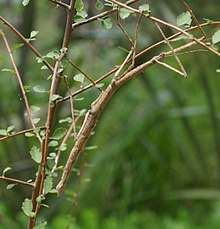
Females can reach up to 20 centimetres (7.9 in) (but are usually 12–15 cm), making this endemic species the longest New Zealand insect.[2] A distinguishing feature is the coxa of the two forelegs is purple or pink. Females are much larger than males and have a visibly spiny thorax. Males are much skinnier and shorter, usually up to 10 centimetres (3.9 in). The colour of A. horridus ranges from pale white to dark brown, with females usually being grey and males being a dark greenish-brown or dark brown.[3]
Life cycle and mating behaviour
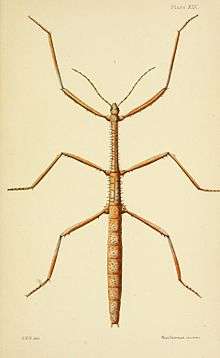
Like many other New Zealand stick insects, A. horridus is facultatively parthenogenetic.[1][4] Because of that, some populations consist of only females who reproduce asexually, while other populations have both males and females and can reproduce by either asexual or sexual reproduction.[5] Adults hatch in early summer and can be seen hanging off their host plant, feeding on it. They are mostly active at night, with males actively searching for females.
Males will mate with females by climbing on to their back, and using the toothed claspers near their genitalia to attach and begin copulation. Males may remain clasped onto a female, even if not mating, in order to mate-guard. Mature females lay eggs continuously throughout their adult life, indiscriminately dropping them to the ground. The large eggs resemble plant seeds, and are well-camouflaged on the forest floor.[6] Eggs hatch in early spring, and nymphs resemble miniature adults. Like other stick insects, A. horridus is hemimetabolous, and nymphs grow by moulting, going through six instars until final adulthood.
- Argosarchus horridus eggs illustrated by Des Helmore
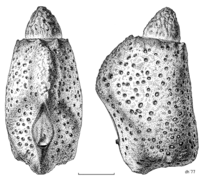
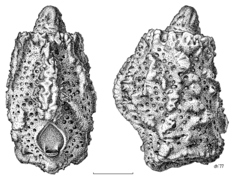
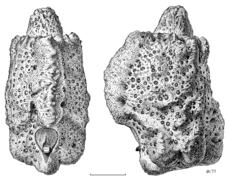
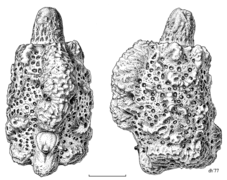
Habitat and distribution
A. horridus is found throughout much of the North Island, as well as some parts of the South Island. It is present in coastal areas from sea level to at least 900 m a.s.l. The species is absent in the central South Island and in high-altitude areas. It has also been found on a number of offshore islands, including the Chatham Islands. It can be found in gardens on ramarama (Lophomyrtus bullata) and in the wild on native and introduced Rubus species (Rosaceae) and climbing rata (Metrosideros perforata).[2] Because of its wide distribution, range of host plants and the various habitats it is found in, A. horridus is considered an ecological generalist.[1][4]
See also
References
- Trewick, Steven A.; Goldberg, Julia; Morgan-Richards, Mary (2005). "Fewer species of Argosarchus and Clitarchus stick insects (Phasmida, Phasmatinae): evidence from nuclear and mitochondrial DNA sequence data". Zoologica Scripta. 34 (5): 483–491. doi:10.1111/j.1463-6409.2005.00204.x. ISSN 0300-3256.
- "Argosarchus Hutton". landcareresearch.co.nz. Landcare Research. Retrieved 30 August 2016.
- Salmon, J. T. (1991). The stick insects of New Zealand. New Zealand: Raupo.
- Buckley, Thomas R.; Marske, Katherine A.; Attanayake, Dilini (2009). "Identifying glacial refugia in a geographic parthenogen using palaeoclimate modelling and phylogeography: the New Zealand stick insect Argosarchus horridus (White)". Molecular Ecology. 18 (22): 4650–4663. doi:10.1111/j.1365-294x.2009.04396.x. ISSN 0962-1083. PMID 19840262.
- Mantovani, Barbara; Marescalchi, Ombretta; Passamonti, Marco; Scali, Valerio (2003-05-01). "Linkage between sexual and asexual lineages: genome evolution in Bacillus stick insects". Biological Journal of the Linnean Society. 79 (1): 137–150. doi:10.1046/j.1095-8312.2003.00172.x. ISSN 0024-4066.
- Hughes, L (1992). "Capitula on stick insect eggs and elaiosomes on seeds: convergent adaptations for burial by ants". British Ecological Society. 6 (6): 642–648. JSTOR 2389958.
External links
- Argosarchus horridus discussed on RNZ Critter of the Week, 22 February 2019